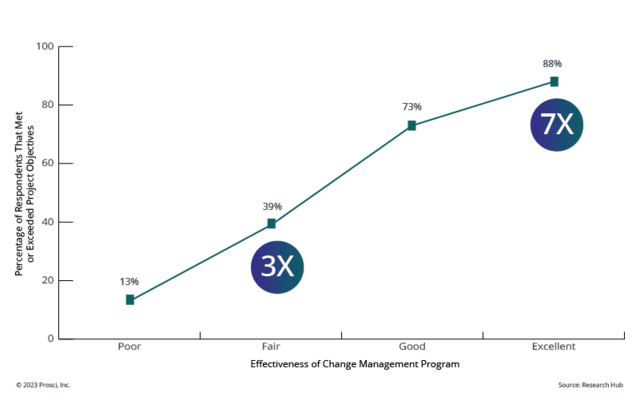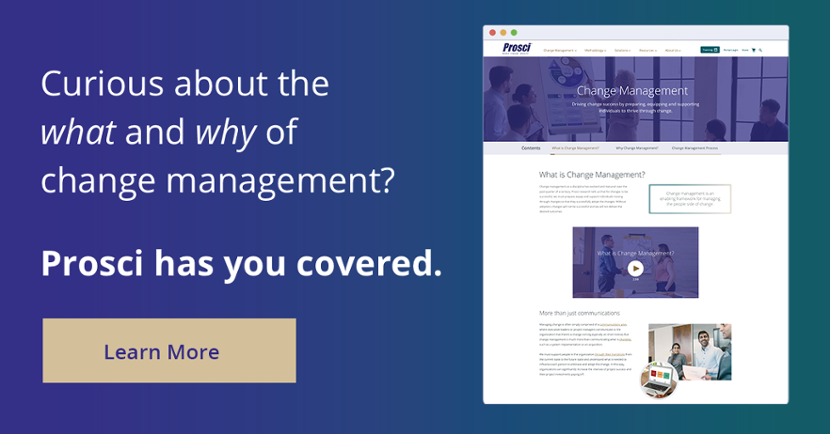Begin With the End in Mind

3 Mins
Updated: August 8, 2024
Published: February 3, 2021

Why do we do change management? To build excellent plans? To abide by best practices in business? To appease our leadership team that decided we needed it? We apply change management because it has a distinct and pointed focus on benefit realization and achieving desired results and outcomes from change.When embarking on our change management journeys, we begin with the end in mind. The end is successful change. And the means to that end is applying a structured approach to help individual employees adopt and use changes that impact them.
Change Management
and Successful Outcomes
Prosci defines change management as "the application of a structured process and set of tools for leading the people side of change to achieve a desired outcome." It is not by accident that the phrase "achieve a desired outcome" completes the definition. By framing change management in this results-oriented way, we overcome assumptions about change management being merely the soft side of change. Change management ensures benefit realization by addressing one of the most critical elements of it: the people side of change.
There is a critical connection between the people who are expected to accept and participate in a change and realizing desired outcomes of that change. To clarify this connection, the examples below illustrate how the same project can result in very different outcomes.
Organization A: without change management
Organization A attempted to implement a change in which employees would submit expense reports electronically instead of using paper. The potential benefits for the organization were great. Processing costs would be lower, error rates would decline, and the timeline of expense tracking would be greatly shortened.

The project team ensured that the proper software was in place and functioning. Employees were mandated to attend training on the new process. After two months, only half of the employees had logged into the new expense reporting system, and 25% of those submitted their reports incorrectly. This required the accounting office to redo many reports manually. What should have resulted in more efficiency ended up being less efficient. The desired objectives went unmet, the implementation schedule had to be extended, and the project went over budget.
Organization B: with change management
 Organization B also attempted to implement a similar electronic expense reporting system.
Organization B also attempted to implement a similar electronic expense reporting system.
The project team employed change management from the beginning of the project. Before sending employees to training, they executed an Awareness-building campaign, sharing the reasons for the change and how it would affect employees. Meanwhile, the project team and change management resources ensured that all key sponsors and managers were on board, engaged in creating Desire for and excitement around the change, and coached individual employees who needed more attention. The project team designed a training session tailored to the specific needs of the employees. They worked with people managers to ensure that employee proficiency aligned with the adoption rates and speeds needed to achieve the desired outcomes.
Following the change implementation, the project team took steps to reinforce new behaviors by publicly rewarding and acknowledging compliance, and soliciting feedback on how to further improve the new process going forward.
Begin With
Benefit Realization in Mind
What benefit does a new process deliver if no one follows it? What benefit does a new technology or system create if no one uses it? Implementing a technical solution is only part of the equation. Putting people at the center of the change and equipping them to embrace, adopt and proficiently use the technical solution is really where benefit realization occurs. The intended results and outcomes of change are inextricably connected to whether that change becomes part of how employees do their jobs. This means that return on investment (ROI) for the project or initiative is directly related to how well the organization manages the people side of change.
Change management effectiveness on project objectives
The correlation below demonstrates that the more effective change management effort is, the more likely we can meet or exceed project objectives. The ROI of change management then, in a way, is the ROI of the project or initiative.

How individual change impacts organizational change
Organizations change for a reason, whether that is to be more competitive in the market, improve business processes, cut costs, or all the above. Organizational change requires individual change. If individuals do not embrace, adopt, and become proficient at using the required change, the benefits will not be realized. Change management is an enabling framework for managing the people side of change. We apply change management to optimize what the organization can achieve with the change.
Equip Individuals
for Organizational Change
By beginning with the end in mind, effective change management equips and enables the individuals affected by the change to embrace, adopt and use the required change, which leads to the desired organizational benefit. From this perspective, we see how applying change management has a positive effect on employees impacted by the change—all while meeting project objectives, finishing on time and on budget, and increasing ROI.

